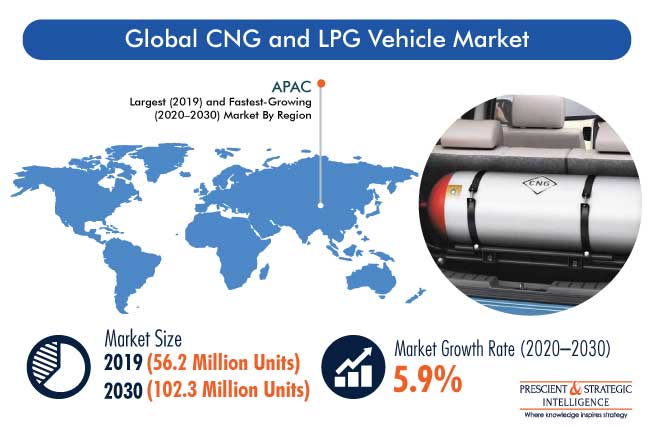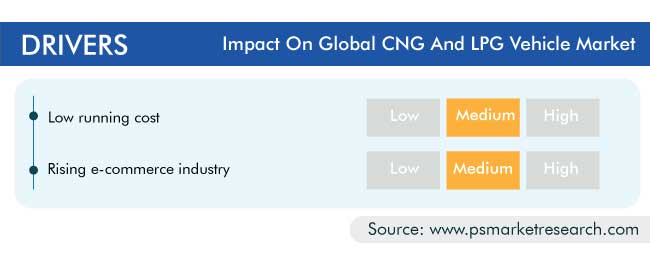Report Code: 10737 | Available Format: PDF | Pages: 130
CNG and LPG Vehicle Market Research Report: By Fuel Type (CNG, LPG), Vehicle Type (Passenger Car, Light and Heavy-Duty Truck, Bus) - Global Industry Analysis and Growth Forecast to 2030
- Report Code: 10737
- Available Format: PDF
- Pages: 130
- Report Description
- Table of Contents
- Market Segmentation
- Request Free Sample
CNG and LPG Vehicle Market Overview
The global compressed natural gas (CNG) and liquefied petroleum gas (LPG) vehicle market registered sales of 56.2 million units in 2019, which is expected to grow at a CAGR of 5.9% during the forecast period (2020–2030). The major factors responsible for the growth of the market include increasing adoption of clean-energy vehicles and ability of CNG and LPG vehicles to replace conventional vehicles. These vehicles are also economically productive in long run and are also value for money for customers.
The COVID-19 pandemic has negatively impacted almost every industry, worldwide. The impact of COVID-19 is severe on the automotive industry as a whole, including the production and sales of CNG and LPG vehicles, due to the lockdowns and closure of production facilities, and also affected by government priorities to divert focus toward more pressing social and economic issues.

CNG Category to Witness Faster Growth During the Forecast Period
Based on fuel type, the CNG category is expected to hold larger market share by 2030 and is projected to progress with higher CAGR throughout the forecast period. The adoption of CNG vehicles for mobility especially in developing countries of APAC is the prime factor that drives the growth of the CNG and LPG vehicle market in this category.
Passenger Cars to Hold Largest Market Share
Based on vehicle type, the passenger cars category is projected to hold the largest market share by 2030. The growth can be primarily attributed to the increasing adoption of CNG- and LPG-based passenger cars, and government initiatives for reducing air pollution.
Asia-Pacific (APAC) Region Held Largest Market Share
Globally, APAC held the largest share, in terms of volume, in the CNG and LPG vehicle market, in 2019. This is attributed to the high growth in the automotive industry in countries such as China, Japan, South Korea, and India. China has been the largest market for CNG and LPG vehicles in the world, with continued dynamic growth.

Low Running Cost
Vehicles that run on CNG and LPG have lower fuel costs, in comparison to conventional fuel vehicles, such as gasoline and diesel vehicles. In Europe, CNG cost ranges from approximately $1.50 to $2.80 per gallon on a gasoline-gallon equivalent basis, which results in decrease of 40–75% of fuel cost, in comparison to the cost of diesel or gasoline. Businesses using CNG-fueled trucks often see payback on the conversion cost in as little as 24–36 months of use. In the U.S., LPG costs approximately $2.00 per gallon, which results up to 50% cost savings per gallon, as compared to gasoline and diesel. Other benefits of LPG include LPG refueling systems typically cost less to install and LPG fuel tanks are smaller than CNG, which results in less loss of cargo or passenger capacity. Thus, low running costs of CNG and LPG vehicles as compared to gasoline vehicles would eventually fuel the demand for these vehicles, worldwide.

Expansion of E-Commerce Industry
In 2019, the e-commerce industry accounted for around 14% of all retail sales, as compared to 10% in 2017. The industry is growing at a tremendous rate, across the globe, therefore, representing a rising share in the overall retail market. Furthermore, it is projected that e-commerce sales will reach around 25% of retail sales, worldwide, by 2025. Thus, with the growing e-commerce industry, the demand for more greener vehicles is expected to increase. Therefore, several companies are relying on cheaper and greener transportation options, in order to be more responsible toward environment. However, burgeoning of electric vehicle (EV) industry might pose a challenge to the market, but higher down payments and costs of EVs are still the major issues for many fleet owners and passenger car owners. Thus, with the expansion of e-commerce industry drives the demand for CNG and LPG vehicles.
| Report Attribute | Details |
Historical Years |
2014-2019 |
Forecast Years |
2020-2030 |
Base Year (2019) Market Size |
56.2 Million Units |
Forecast Period CAGR |
5.9% |
Report Coverage |
Market Trends, Volume Estimation and Forecast, Segmentation Analysis, Country Breakdown, Competitive Analysis, Companies’ Strategic Developments, Impact of COVID-19, Company Profiling, Value Chain Analysis, Market Share Analysis |
Market Size by Segments |
Fuel Type, Vehicle Type, Region |
Market Size of Geographies |
U.S., Canada, Russia, Italy, Ukraine, Germany, France, Netherlands, Spain, India, China, South Korea, Thailand, Iran, Argentina, Brazil |
Secondary Sources and References (Partial List) |
American Automobile Association (AAA), American Chemical Society, American Public Transportation Association (APTA), American Supply Association (ASA), American Trucking Associations (ATA), Asia-Pacific Logistics Federation (APLF), China Communications and Transportation Association (CCTA), Department of Transportation (DoT), European Automobile Manufacturers Association (ACEA), Germany Trade and Invest (GTAI), International Energy Agency (IEA), National Association of Foreign-Trade Zones (NAFTZ) |
Explore more about this report - Request free sample
Players Are Engaging in Mergers and Acquisitions to Gain Competitive Edge in the Market
In recent years, the players in the global CNG and LPG vehicle market have been actively involved in mergers and acquisitions to stay ahead in the competition.
- In January 2020, GDR Taxi signed a deal with Phoenix LPG Philippines Inc. (a subsidiary of Phoenix Petroleum Philippines Inc.) to convert its fleet of over 200 vehicles operating all over Iloilo City and nearby provinces to LPG, in order to provide more environment-friendly vehicles.
- In December 2019, Maxquip Inc. acquired the assets of Canso Propane Conversions, an Ontario-based company that has expertise in converting cars and trucks to run on LPG. This investment is expected to provide Maxquip Inc. with a greater ability to be a wholesaler of autogas conversion solutions as well as it would strengthen installer in the Toronto market.
Some Key Players of CNG and LPG Vehicle Industry Include:
-
Ford Motor Co.
-
General Motors Co.
-
Fiat Chrysler Automobiles N.V.
-
Toyota Motor Corporation
-
Honda Motors Co. Ltd.
-
Tata Motors Ltd.
-
AB Volvo
-
Daimler AG
-
Suzuki Motors Corp.
-
Volkswagen AG
-
Landi Renzo S.P.A
-
Tartarini Auto S.R.L.
-
Tomasetto Achille SpA
-
Westport Fuel Systems Inc.
CNG and LPG Vehicle Market Size Breakdown by Segments
The CNG and LPG vehicle market report offers comprehensive market segmentation analysis along with market estimation for the period 2014-2030.
Based on Fuel Type
- CNG
- LPG
Based on Vehicle Type
- Passenger Car
- Light and Heavy-duty Truck
- Bus
Geographical Analysis
- North America
- U.S.
- Canada
- Europe
- Germany
- Russia
- Ukraine
- Netherlands
- France
- Italy
- Spain
- Asia-Pacific (APAC)
- China
- India
- Thailand
- South Korea
- Latin America, the Middle East and Africa (LAMEA)
- Brazil
- Iran
- Argentina
In 2030, the CNG and LPG vehicle market is expected to witness a sale of 102.3 million units.
CNG-driven automobiles dominate the CNG and LPG vehicle industry.
LAMEA offers the most-lucrative opportunities in the CNG and LPG vehicle market.
The CNG and LPG vehicle industry is driven by the low running cost of such automobiles and prospering e-commerce sector.
The CNG and LPG vehicle market report has three segments: fuel type, vehicle type, and region.
Want a report tailored exactly to your business strategy?
Request CustomizationWant an insight-rich discussion with the report author?
Speak to AnalystOur dedication to providing the most-accurate market information has earned us verification by Dun & Bradstreet (D&B). We strive for quality checking of the highest level to enable data-driven decision making for you
Our insights into the minutest levels of the markets, including the latest trends and competitive landscape, give you all the answers you need to take your business to new heights
With 24/7 research support, we ensure that the wheels of your business never stop turning. Don’t let time stand in your way. Get all your queries answered with a simple phone call or email, as and when required
We take a cautious approach to protecting your personal and confidential information. Trust is the strongest bond that connects us and our clients, and trust we build by complying with all international and domestic data protection and privacy laws